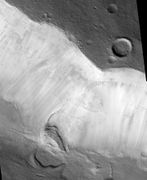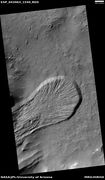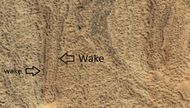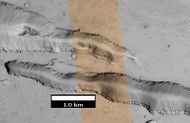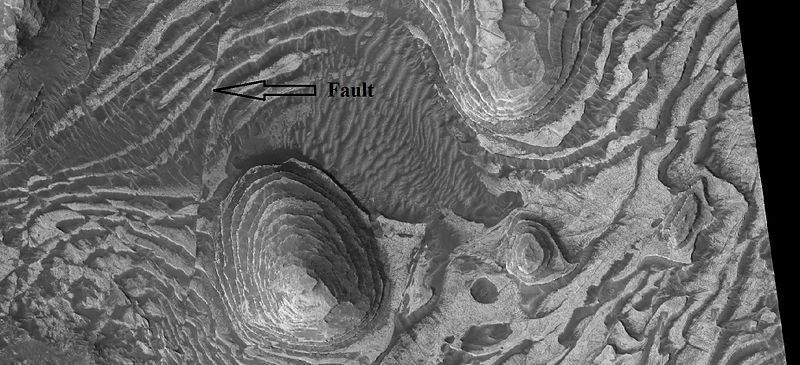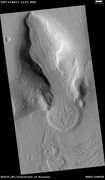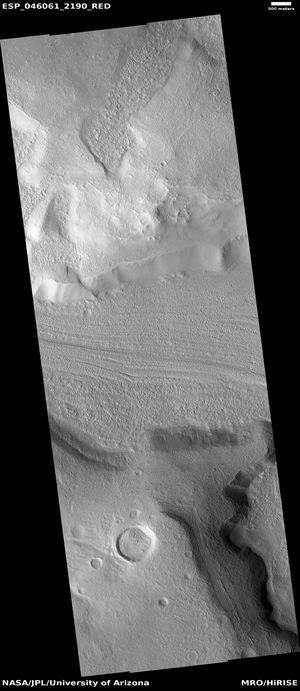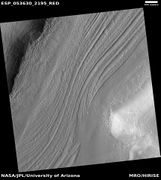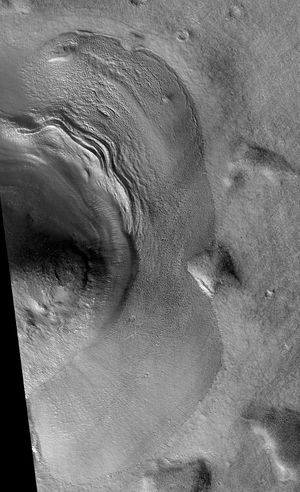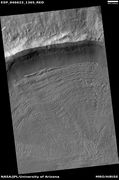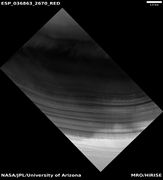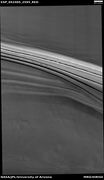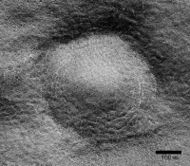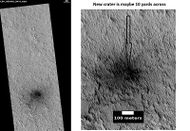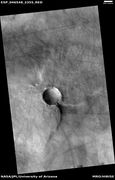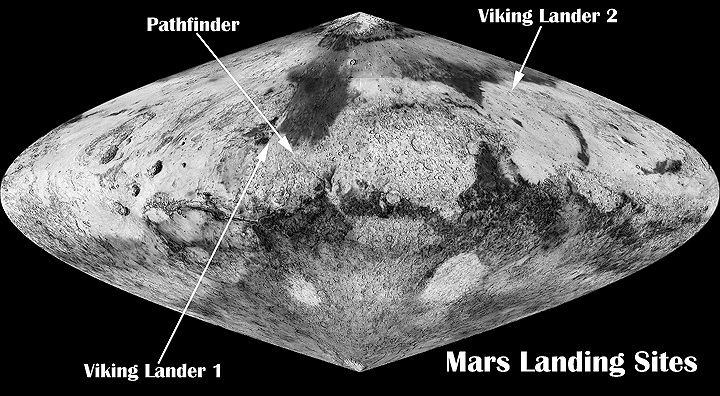Difference between revisions of "HiWish program"
m (→Glaciers) |
m (→Glaciers) |
||
| Line 123: | Line 123: | ||
File:ESP 050176 2245glacier.jpg|Glacier moving out of a valley | File:ESP 050176 2245glacier.jpg|Glacier moving out of a valley | ||
File:ESP 045085 2205flowlabeled.jpg|Alpine Glacier moving out of a valley and then moving onto Lineated valley fill (LVF) The LVF contains ice under a layer of insulating debris. Lineated Valley Fill is considered to be a glacier. | File:ESP 045085 2205flowlabeled.jpg|Alpine Glacier moving out of a valley and then moving onto Lineated valley fill (LVF) The LVF contains ice under a layer of insulating debris. Lineated Valley Fill is considered to be a glacier. | ||
| − | File: | + | File:ESP_47193_1440 |
</gallery> | </gallery> | ||
Revision as of 17:43, 21 February 2020
HiWish is a NASA program in which anyone can suggest a place for the High Resolution Imaging Science Experiment (HiRISE) camera on the Mars Reconnaissance Orbiter to image.[1] [2] [3] It started in January 2010. Three thousand people signed up in the first few months of the program.[4] [5] The first images were released in April 2010.[6] Over 12,000 suggestions were made by the public; suggestions were made for targets in each of the 30 quadrangles of Mars. Some of the images from HiWish were used for three talks at the 16th Annual International Mars Society Convention. Below are some of the over 4,224 images that have been released from the HiWish program as of March 2016.[7]
Contents
- 1 Landslides
- 2 Hollows
- 3 Mud Volcanoes
- 4 Volcanic vents
- 5 Lava Flows
- 6 Rootless Cones
- 7 Dikes
- 8 Troughs
- 9 Faults
- 10 Mesas and layers
- 11 Layers in Craters
- 12 Dipping Layers
- 13 Boulders
- 14 Yardangs
- 15 Ring-Mold Craters
- 16 Dark Slope Streaks
- 17 Dust Devil Tracks
- 18 Dunes
- 19 Glaciers
- 20 Lineated Valley Fill (LVF)
- 21 Lobate Debris Aprons (LDA’s)
- 22 Concentric Crater Fill (CCF)
- 23 Brain Terrain
- 24 Ice Cap Layers
- 25 Spiders
- 26 Mantle
- 27 Polygons
- 28 Scalloped Terrain
- 29 Pingos
- 30 Gullies
- 31 Craters
- 32 Hellas Floor Features
- 33 Channels
- 34 Streamlined Shapes
- 35 Inverted Terrain
- 36 Exhumed Craters
- 37 Pedestal Craters
- 38 Ridges
- 39 How to suggest image
- 40 References
- 41 See Also
- 42 Recommended reading
- 43 External links
Landslides
Landslides have been observed on Mars. They may be a little different since the gravity of Mars is only about one third as that of the Earth.
Hollows
Hollows make strange, beautiful landscapes. The hollows are believed to be produced when ice leaves the ground and the remaining dust is blown away. There is much water frozen in the ground. Water is carried around the planet frozen on dust grains that fall to the ground and make up what is called “mantle.” Mantle is produced when the climate is such that there is a lot of dust and moisture in the atmosphere. During those times, water will freeze onto the dust particles. Eventually, the particles will be too heavy and fall to the surface. In addition it may snow on Mars. The mantle covers wide expanses. It has a smooth appearance. It covers the irregular, created surface of the planet.
- 28207 2250
Hollows
- 46325 2225hollows
Wide view of field of hollows
- 46325 2225hollows4
Mud Volcanoes
Mud volcanoes are very common in a place on Mars called the Mare Acidalium quadrangle. Because they bring up mud from underground, they may hold evidence of life.[8] Mud that formed the volcanoes comes from a depth underground that is deep enough to be protected from radiation. The radiation level at the surface would kill most organisms over time. Methane has been detected on Mars; methane may be produced by certain bacteria. Some scientists speculate that methane may come from mud volcanoes.[9]
Volcanic vents
Lava Flows
Large areas of Mars are covered with lava flows.[10] [11] [12] [13] Large volcanoes in the Tharsis region show many overlapping lava flows. Lava flows can also move around and create what appear to be layers, especially if it behaves like water. Basalt flows are very fluid.[14]
Rootless Cones
Rootless Cones are thought to be caused by lava flowing over ice or ground containing ice. Heat from the lava causes the ice to quickly change to steam. The resulting steam explosion produces a ring or cone. Such features are common in certain locations on the Earth. Some of the forms do not have the shape of rings or cones because maybe the lava moved too quickly; thereby not allowing a complete cone shape to form. Sometimes a wake is made as the lava moves along the surface.
Dikes
Dikes show as mostly straight ridges. They are made when magma flows along cracks or faults in the ground. This part of the process happens under the ground. Later erosion will remove the weaker materials around the dike. What is left is a narrow wall of rock.[15] On Mars many faults are due to stretching of the crust. The mass of huge volcanoes pull at the crust until it cracks.
Troughs
Troughs are common on Mars. They are due to the great weight of several huge volcanoes on Mars. The mass of these structures has caused the crust to stretch. That tension made the crust break into cracks called, “troughs” or “fossae.” Some of them show evidence that lava and/or water have come out of them in the past. They can be very long.[16] [17] [18]
Faults
Faults are visible in some parts of Mars. They are most noticeable in places where many layers exist. Sometimes their presence is know because they can change the direction of stream channels.
Mesas and layers
On Mars much layered terrain is visible. Layered rock is formed from separate events. For example, a layer may be formed at the bottom of a lake. Later, lava may cover that layer, thus making a new layer—one that is harder. In times erosion may remove nearly all the layers. But, sometimes remnants are left behind, especially if they are topped off by a hard cap rock. Lave flows can make cap rock. The cap rock will protect the underlying rocks from erosion. Cap rock often breaks up into large boulders. Sometimes the boulders are in the shape of cube-shaped blocks. Many, large areas of Mars have eroded in such a fashion. The remaining structures are called mesas or buttes—if they are small in area. Some mesas and buttes show layers. Mesas show the kind of material that covered a wide area. Mesas are what are left after the ground is mostly eroded.
Layers in Craters
Craters can contain mesas that show layers. It is believed that these layers are the remnants of material that once covered a wide area, but is now only in protected places like inside craters. The layers mean that different events laid down the layers. These layers are probably due to latitude dependent mantle that falls from the sky at different times. Mantle is mostly from ice-coated dust falling from the sky under certain climate conditions. Wind, acting over millions of years, will shape the material in craters into smooth mesas.
Dipping Layers
A common feature on Mars is “dipping layers.” They are groups or stacks of layers that seem to be leaning against something steep like a crater wall or the wall of a mesa. It is believed that they represent material that once covered a wide area, but is now only in protected places. The layers mean that different events laid down the layers. These layers are probably due to latitude dependent mantle that falls from the sky at different times. Mantle is mostly from ice-coated dust falling from the sky under certain climate conditions. These dipping layers are often smooth from the action of the wind over millions of years.
Boulders
Large, house-sized boulders are widespread on the Red Planet. Mars has an old surface—billions of years old. In that time, erosion has broken down many hard rocks. Most of Mars is covered with hard volcanic rock. The dark volcanic rock basalt covers most of the Martian surface. When it breaks, it first forms large boulders.
Yardangs
Yardangs develop from fine-grained material. They are shaped by the wind and show the direction of the dominant winds.[19] [20] Volcanoes supply much of this fine-grained material. Yardangs are especially widespread in what's called the "Medusae Fossae Formation." This formation is found in the Amazonis quadrangle and near the equator.[21] Because yardangs exhibit very few impact craters they are believed to be relatively young.[22] The largest single source of dust in the air on Mars comes from the Medusae Fossae Formation.[23]
Ring-Mold Craters
Ring-mold craters are a type of small impact crater that looks like the ring molds used in baking.[24] [25] One popular idea for their formation is an impact into ice--Ice that is covered by a layer of debris.Cite error: Closing </ref> missing for <ref> tag [26] [27] Ring-mold craters may be an easy way for future colonists of Mars to find water ice because some may contain ice that is relatively pure. And, since it was generated during a rebound, ice may have been brought up from below the surface; hence, less digging or drilling may be required to gather ice.
Dark Slope Streaks
Dark slope streaks are avalanche-like features common on dust-covered slopes.[28] These streaks have never been observed on the Earth.[29] They form in relatively steep terrain, such as along cliffs and crater walls.[30] Although they appear much darker than their surroundings, the darkest streaks are only about 10% darker than their backgrounds. Streaks seem much darker because of contrast enhancement in the image processing.[31]
Dust Devil Tracks
Dust devil tracks can be very beautiful. They are made by giant dust devils removing bright colored dust from the Martian surface. As a result, dark underlying material is exposed.[32] Dust devils on Mars have been photographed both from the ground and from orbit. They helped scientists by blowing dust off the solar panels of two Rovers on Mars, thereby greatly extending their useful lifetime.[33] Dust devils can be 650 meters high and 50 meters across.[34] The pattern of the tracks has been shown to change every few months.[35]
Dunes
![Colorful dunes in the Mare Tyrrhenum quadrangle[37]](/images/3/3e/ESP_034745_1665blue_dunes.jpg) Some places on Mars have many beautiful dark dunes. Rovers on the Martian surface confirmed earlier ideas that the dunes are composed of sand made from the volcanic rock basalt..[38] Dunes are often covered by a seasonal carbon dioxide frost that forms in early autumn and remains until late spring. As the frost disappears, different patterns can emerge on the dunes. Dunes can take on different colors because of slight chemical variations in the sand grains.
Some places on Mars have many beautiful dark dunes. Rovers on the Martian surface confirmed earlier ideas that the dunes are composed of sand made from the volcanic rock basalt..[38] Dunes are often covered by a seasonal carbon dioxide frost that forms in early autumn and remains until late spring. As the frost disappears, different patterns can emerge on the dunes. Dunes can take on different colors because of slight chemical variations in the sand grains.
Glaciers
Glaciers have been described as “rivers of ice.” With glaciers there is a downward movement that can be noticed by examining patterns on their surface. There are large areas on Mars that contain what is thought to be ice moving under a cover of debris. Exposed ice will not last long under present climate conditions on Mars, but just a few meters of debris can preserve ice for long periods of time.[39] Researchers noticed decades ago that many forms on Mars resembled glaciers on the Earth. As scientists received pictures with greater resolution, the shapes and patterns visible on their surfaces looked like the flows visible in the Earth’s glaciers.
- ESP 47193 1440
Lineated Valley Fill (LVF)
Lineated valley floor consists of many mostly parallel ridges and grooves on the floors of many channels. The ridges and grooves look like they moved around obstacles. They are believed to be ice-rich. Some glaciers on the Earth show such features.

Lobate Debris Aprons (LDA’s)
Lobate debris aprons (LDAs), first seen by the Viking Orbiters, look like piles of rock debris below cliffs.[40] [41] They slope away from mesas and buttes. The Mars Reconnaissance Orbiter's Shallow Radar found pure ice in LDA’s around many mesas.[42] Based on this data, LDA’s are considered to be glaciers covered with a thin layer of rocks.[43][44] [45] [46] [47] [48]
Concentric Crater Fill (CCF)
Concentric crater fill is believed to be an ice-rich feature on the floors of many Martian craters. The floor of craters exhibiting CCF is almost totally covered with many parallel ridges.[49] It is common in the mid-latitudes of Mars,[50] [51] and is widely accepted as caused by glacial movement.[52] [53] The Ismenius Lacus quadrangle contains examples of concentric crater fill.
Brain Terrain
Brain terrain is an area of maze-like ridges 3–5 meters high. A person could wander between these ridges like a rat in a maze. Some ridges may consist of an ice core, so they may be sources of water for future colonists. There are two kinds—open and closed. Brain terrain is thought to begin with cracks that get larger and larger as ice leaves the ground. When ice is exposed on Mars under its present climate conditions, ice goes directly into the air. That process of going from a solid to a gas—instead of first to a liquid—is called sublimation. With this process, the cracks get wider and wider until a complex of high and low areas remains. [54]
Ice Cap Layers
The northern ice cap of layers displays many layers. These layers are visible when a valley cuts through the cap. Layers in the ice cap, as with other exposures of layers across the planet, are formed from frequent dramatic changes in the climate. These changes are the result of great changes in the rotational axis or tilt of the planet. Mars does not have a large moon to stabilize its' tilt; hence the planet has huge variations in its tilt (maybe from its present Earth-like tilt to over twice the Earth’s).
Spiders
Some features have been called spiders because they can resemble spiders. The official name for spiders is "araneiforms."As the temperature goes up in the spring, pressurized carbon dioxide gas and dark dust are released from under slabs of ice.[55] This process results in the appearance of dark plumes that are often blown in one direction by local winds. Besides producing plumes, dust darkens channels under the ice and forms dark shapes that resemble spiders.[56] [57] [58] [59]
Mantle
Mantle on Mars appears as a smooth surface. It covers the normal irregular surface of the planet. It is often called “Latitude Dependent Mantle” because it occurs at certain distances from the equator (certain latitudes).[60] This latitude dependent mantle is believed to fall from the sky. During certain climatic conditions, moisture from the air will freeze onto dust particles. When they become too heavy, these particles fall to the ground. Snow may also fall on to the mantle. So, mantle consists of ice with dust. Since Mantle has a widespread distribution, it may be a major source of water for future colonists. Sometimes mantle displays layers because it was deposited at different times. The climate of Mars has changed many times due to a lack of a large moon. Our Earth’s moon is very massive and that helps to control the tilt of the rotational axis of our Earth. In other words, our moon keeps our planet’s tilt from changing much. Changes in the tilt of a planet will cause major changes in climate.
Polygons
Many surfaces on Mars have polygon shapes. These areas are sometimes called “polygonal patterned ground.” The polygons can be of different shapes and sizes—often very beautiful. They are believed to be caused by ice in the ground because they occur on the Earth where there is ice in the ground. In the future they may help point us to supplies of ice for colonists. The locations of polygons will provide evidence for us to make detailed maps for locations of water before we send crews to live there.
Scalloped Terrain
Scalloped topography or terrain is common in the mid-latitudes of Mars, between 45° and 60° north and south. It is especially prominent in the region called “Utopia Planitia.”[61] [62] This terrain displays shallow, rimless depressions with scalloped edges--commonly referred to as "scalloped depressions" or simply "scallops". Scalloped depressions can be isolated or clustered and sometimes seem to coalesce. The usual scalloped depression displays a gentle equator-facing slope and a steeper pole-facing scarp.[63] Scalloped topography may be of great importance for future colonization of Mars because radar studies reveal it is ice-rich.[64] [65] [66]
Pingos
For many years, Pingos were believed to be present on Mars. Since they contain pure water ice, they would be a great source of water for future colonists on Mars. One picture from HiRISE under the HiWish program was thought to be a pingo.
Gullies
Martian gullies are narrow channels and their associated downslope deposits. They are found on steep slopes. Most are seen on the walls of craters. Many are visible near 40 degrees north and south of the equator. Usually, each gully has an alcove at its head, a fan-shaped apron at its base, and a channel linking the two.[67] They are believed to be relatively young because they have few, if any craters. For many years, gullies were thought to be caused by recent running water. But since some are being formed today, even when the climate of Mars is too cold for running water to exist on the surface, there must be another cause. After more observations, it was shown that pieces of dry ice moving down slopes could cause them. Nevertheless, some scientists think that in the past, water may have been involved in their formation.
Gullies in Phaethontis quadrangle Ridges at the end of the gullies may be the remains of old glaciers.[68]
Craters
Craters cover nearly all parts of Mars. Most of the surface of Mars is over a billion years old. Because Mars has not had active plate tectonics for a very long time (if it ever had active plate tectonics), impact craters stay for a long time. There are many kinds of craters on the planet.[69] [70]
Layered mound in crater Layers represent material that once covered a wide area. Mound was shaped by winds.[71]
Hellas Floor Features
The Hellas floor contains strange-looking features that look like some sort of abstract art. One such feature is called "banded terrain." [72] [73] [74] This terrain has also been called "taffy pull" terrain, and it lies near honeycomb terrain, another strange surface.[75] Banded terrain is found in the north-western part of the Hellas basin, the deepest section. The bands can be classified as linear, concentric, or lobate. Bands are typically 3–15km long and 3km wide. Narrow inter-band depressions are 65 m wide and 10 m deep.[76] How these shapes were made is still a mystery, although some explanations have been advanced.
Channels
There are thousands of channels that were caused by running water in the past on Mars. Some are large; some are tiny.[77] [78] [79] [80] [81] These channels have been seen in pictures from spacecraft for nearly 50 years. Current climate models do not support a warm climate on Mars; consequently, various ideas have been advanced to explain the existence of so many channels when it may have always been too cold for liquid water to exist on the surface. Some say they could be formed under ice sheets. Other scientists maintain that they could be produced in short periods after an asteroid impact warms the planet for thousands of years.
Streamlined Shapes
Some locations on Mars show clear evidence of massive flows of water in the past. During these floods, the ground was carved into streamlined shapes. There are several ideas for how all this happened. It may have resulted from asteroid impacts into frozen ground. Under a cap of frozen ground there may have been vast buildups of water that were suddenly released.
Inverted Terrain
Often low areas can become high areas. This frequently happens with streams. An old stream channel may become filled with a hard, erosion resistant material like lava or large boulders. Later, erosion of the whole area may remove all the surrounding soft materials. But, the stream channel will be preserved because of the hard materials that were deposited in it. In the end, you are left with a feature which is elevated above the landscape, but has the shape of the original stream. Geologists will then call the stream “inverted.”
Exhumed Craters
Exhumed terrain appears to be in the process of being uncovered.[82] The surface of Mars is very old. Places have been covered, uncovered, and covered again by sediments. The pictures below show a crater that is being exposed by erosion. When a crater forms, it will destroy what's under and around it. In the example below, only part of the crater is visible. Had the crater been created after the layered feature, it would have removed part of the feature and we would see the entire crater.
Pedestal Craters
A Pedestal crater is a crater with its ejecta sitting above the surrounding terrain. Its ejecta form a raised platform (like a pedestal). They are produced when an impact ejects material that forms an erosion-resistant layer. Consequently, the immediate area erodes more slowly than the rest of the region. Some pedestals are hundreds of meters above the surroundings. This means that hundreds of meters of material were eroded away. What remains is a crater and its ejecta blanket sitting above the surrounding ground. [83] [84] [85]
Ridges
Ridge fields are another feature that we do not yet fully understand. Hard ridges standing above the surroundings often meet at close to right angles. They may have something to do with cracks caused by impacts. Mineral laden water may then migrate up the cracks and harden. These fields can be quite complex and beautiful.
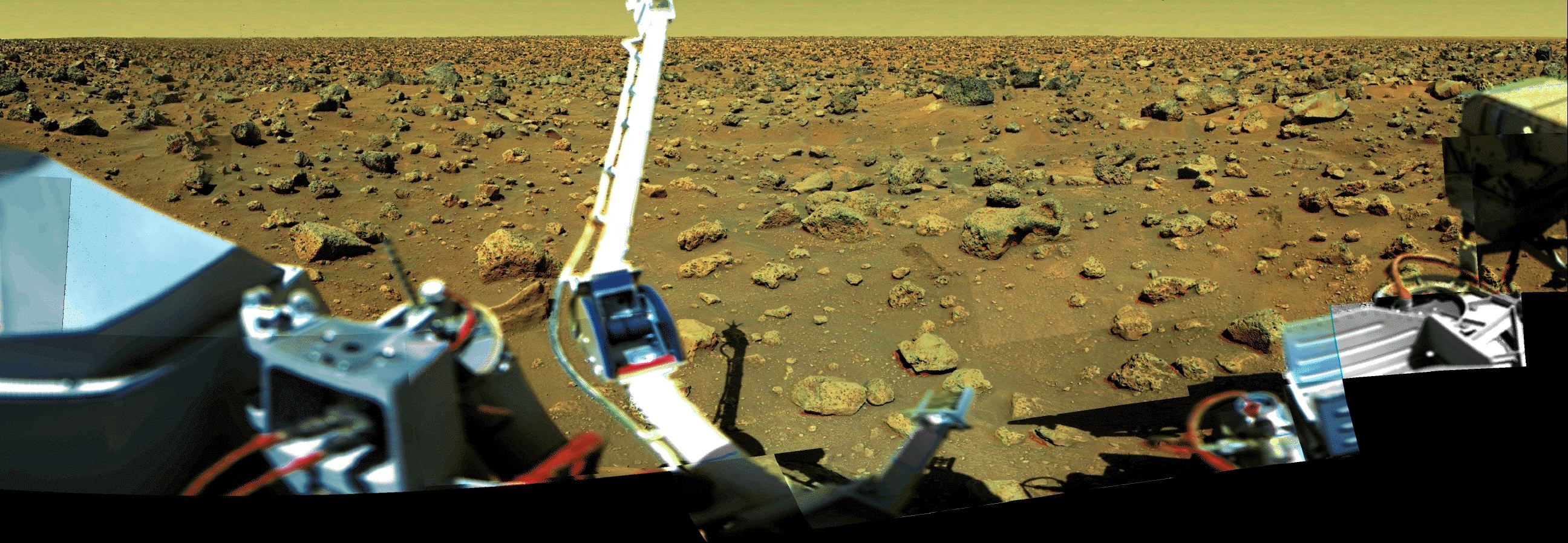 View of surface around Viking 2
View of surface around Viking 2
How to suggest image
To suggest a location for HiRISE to image visit the site at http://www.uahirise.org/hiwish
In the sign up process you will need to come up with an ID and a password. When you choose a target to be imaged, you have to pick and exact location on a map and write about why the image should be taken. If your suggestion is accepted, it may take 3 months or more to see your image. You will be sent an email telling you about your images. The emails usually arrive on the first Wednesday of the month in the late afternoon.
References
- ↑ Template:Cite web
- ↑ http://www.astronomy.com/magazine/2018/08/take-control-of-a-mars-orbiter
- ↑ http://www.planetary.org/blogs/guest-blogs/hiwishing-for-3d-mars-images-1.html
- ↑ Interview with Alfred McEwen on Planetary Radio, 3/15/2010
- ↑ Template:Cite web
- ↑ Template:Cite web
- ↑ McEwen, A. et al. 2016. THE FIRST DECADE OF HIRISE AT MARS. 47th Lunar and Planetary Science Conference (2016) 1372.pdf
- ↑ Wheatley, D., et al., 2019. Clastic pipes and mud volcanism across Mars: Terrestrial analog evidence of past Martian groundwater and subsurface fluid mobilization. Icarus. In Press
- ↑ https://hirise.lpl.arizona.edu/ESP_055307_2215
- ↑ https://en.wikipedia.org/wiki/Volcanology_of_Mars
- ↑ Head, J.W. 2007. The Geology of Mars: New Insights and Outstanding Questions in The Geology of Mars: Evidence from Earth-Based Analogs, Chapman, M., Ed; Cambridge University Press: Cambridge UK
- ↑ Carr, Michael H. (1973). "Volcanism on Mars". Journal of Geophysical Research. 78 (20): 4049–4062.
- ↑ Barlow, N.G. 2008. Mars: An Introduction to Its Interior, Surface, and Atmosphere; Cambridge University Press: Cambridge, UK
- ↑ https://www.uahirise.org/ESP_057978_1875
- ↑ "Characteristics and Origin of Giant Radiating Dyke Swarms". MantlePlumes.org.
- ↑ https://en.wikipedia.org/wiki/Fossa_(geology)
- ↑ James W. Head; Lionel Wilson; Karl L. Mitchell (2003). "Generation of recent massive water floods at Cerberus Fossae, Mars by dike emplacement, cryospheric cracking, and confined aquifer groundwater release". Geophysical Research Letters. 30 (11): 2265. Bibcode:2003GeoRL..30k..31H. doi:10.1029/2003GL017135
- ↑ Burr, D. et al. 2002. Repeated aqueous flooding from the Cerberus Fossae: evidence for very recently extant deep groundwater on Mars. Icarus. 159: 53-73.
- ↑ Bridges, Nathan T.; Muhs, Daniel R. (2012). "Duststones on Mars: Source, Transport, Deposition, and Erosion". Sedimentary Geology of Mars. pp. 169–182. doi:10.2110/pec.12.102.0169. ISBN 978-1-56576-312-8.
- ↑ https://www.uahirise.org/ESP_039563_1730
- ↑ http://adsabs.harvard.edu/abs/1979JGR....84.8147W SAO/NASA ADS Astronomy Abstract Service: Yardangs on Mars
- ↑ http://themis.asu.edu/zoom-20020416a
- ↑ Ojha, Lujendra; Lewis, Kevin; Karunatillake, Suniti; Schmidt, Mariek (2018). "The Medusae Fossae Formation as the single largest source of dust on Mars". Nature Communications. 9 (1): 2867.
- ↑ https://link.springer.com/referenceworkentry/10.1007/978-1-4614-9213-9_318-1
- ↑ kress, A., J. Head. 2008. Ring‐mold craters in lineated valley fill and lobate debris aprons on Mars: Evidence for subsurface glacial ice. Geophysical Research Letters Volume 35, Issue 23
- ↑ Baker, D. et al. 2010. Flow patterns of lobate debris aprons and lineated valley fill north of Ismeniae Fossae, Mars: Evidence for extensive mid-latitude glaciation in the Late Amazonian. Icarus: 207. 186-209
- ↑ Kress., A. and J. Head. 2009. Ring-mold craters on lineated valley fill, lobate debris aprons, and concentric crater fill on Mars: Implications for near-surface structure, composition, and age. Lunar Planet. Sci: 40. abstract 1379
- ↑ Chuang, F.C.; Beyer, R.A.; Bridges, N.T. 2010. Modification of Martian Slope Streaks by Eolian Processes. Icarus, 205 154–164.
- ↑ Heyer, T., et al. 2019. Seasonal formation rates of martian slope streaks. Icarus
- ↑ Schorghofer, N.; Aharonson, O.; Khatiwala, S. 2002. Slope Streaks on Mars: Correlations with Surface Properties and the Potential Role of Water. Geophys. Res. Lett., 29(23), 2126.
- ↑ Sullivan, R. et al. 2001. Mass Movement Slope Streaks Imaged by the Mars Orbiter Camera. J. Geophys. Res., 106(E10), 23,607–23,633.
- ↑ https://www.uahirise.org/ESP_058427_1080
- ↑ http://marsrovers.jpl.nasa.gov/gallery/press/spirit/20070412a.html Mars Exploration Rover Mission: Press Release Images: Spirit. Marsrovers.jpl.nasa.gov
- ↑ https://www.uahirise.org/ESP_061787_2140
- ↑ http://hirise.lpl.arizona.edu/PSP_005383_1255
- ↑ https://www.uahirise.org/ESP_057071_1890
- ↑ https://www.uahirise.org/ESP_057071_1890
- ↑ Lorenz, R. and J. Zimbelman. 2014. Dune Worlds How Windblown Sand Shapes Planetary Landscapes. Springer. NY.
- ↑ Head, J. W.; et al. (2006). "Extensive valley glacier deposits in the northern mid-latitudes of Mars: Evidence for Late Amazonian obliquity-driven climate change". Earth and Planetary Science Letters. 241 (3): 663–671.
- ↑ Carr, M. 2006. The Surface of Mars. Cambridge University Press.
- ↑ Squyres, S. 1978. Martian fretted terrain: Flow of erosional debris. Icarus: 34. 600-613.
- ↑ http://www.planetary.brown.edu/pdfs/3733.pdf
- ↑ Head, J. et al. 2005. Tropical to mid-latitude snow and ice accumulation, flow and glaciation on Mars. Nature: 434. 346-350
- ↑ http://www.marstoday.com/news/viewpr.html?pid=18050
- ↑ http://news.brown.edu/pressreleases/2008/04/martian-glaciers
- ↑ Plaut, J. et al. 2008. Radar Evidence for Ice in Lobate Debris Aprons in the Mid-Northern Latitudes of Mars. Lunar and Planetary Science XXXIX. 2290.pdf
- ↑ Holt, J. et al. 2008. Radar Sounding Evidence for Ice within Lobate Debris Aprons near Hellas Basin, Mid-Southern Latitudes of Mars. Lunar and Planetary Science XXXIX. 2441.pdf
- ↑ Petersen, E., et al. 2018. ALL OUR APRONS ARE ICY: NO EVIDENCE FOR DEBRIS-RICH “LOBATE DEBRIS APRONS” IN DEUTERONILUS MENSAE 49th Lunar and Planetary Science Conference 2018 (LPI Contrib. No. 2083). 2354.
- ↑ https://web.archive.org/web/20161001224229/http://hiroc.lpl.arizona.edu/images/PSP/diafotizo.php?ID=PSP_111926_2185
- ↑ Dickson, J. et al. 2009. Kilometer-thick ice accumulation and glaciation in the northern mid-latitudes of Mars: Evidence for crater-filling events in the Late Amazonian at the Phlegra Montes. Earth and Planetary Science Letters.
- ↑ http://hirise.lpl.arizona.edu/PSP_001926_2185%7Ctitle=HiRISE - Concentric Crater Fill in the Northern Plains (PSP_001926_2185)|author=|date=|website=hirise.lpl.arizona.edu
- ↑ Head, J. et al. 2006. Extensive valley glacier deposits in the northern mid-latitudes of Mars: Evidence for late Amazonian obliquity-driven climate change. Earth Planet. Sci Lett: 241. 663-671.
- ↑ Levy, J. et al. 2007. Lineated valley fill and lobate debris apron stratigraphy in Nilosyrtis Mensae, Mars: Evidence for phases of glacial modification of the dichotomy boundary. J. Geophys. Res.: 112.
- ↑ Levy, J., J. Head, D. Marchant. 2009. Concentric crater fill in Utopia Planitia: History and interaction between glacial “brain terrain” and periglacial mantle processes. Icarus 202, 462–476.
- ↑ Portyankina, G., et al. 2019. How Martian araneiforms get their shapes: morphological analysis and diffusion-limited aggregation model for polar surface erosion Icarus. https://doi.org/10.1016/j.icarus.2019.02.032
- ↑ Kieffer H, Christensen P, Titus T. 2006 Aug 17. CO2 jets formed by sublimation beneath translucent slab ice in Mars' seasonal south polar ice cap. Nature: 442(7104):793-6.
- ↑ https://mars.nasa.gov/resources/possible-development-stages-of-martian-spiders/
- ↑ http://themis.asu.edu/news/gas-jets-spawn-dark-spiders-and-spots-mars-icecap
- ↑ http://spaceref.com/mars/how-gas-carves-channels-on-mars.html
- ↑ Kreslavsky, M., J. Head, J. 2002. Mars: Nature and evolution of young, latitude-dependent water-ice-rich mantle. Geophys. Res. Lett. 29, doi:10.1029/ 2002GL015392.
- ↑ last1 = Lefort | first1 = A. | last2 = Russell | first2 = P. | last3 = Thomas | first3 = N. | last4 = McEwen | first4 = A.S. | last5 = Dundas | first5 = C.M. | last6 = Kirk | first6 = R.L. | year = 2009 | title = HiRISE observations of periglacial landforms in Utopia Planitia | url = http://www.agu.org/pubs/crossref/2009/2008JE003264.shtml | journal = Journal of Geophysical Research | volume = 114 | issue = | page = E04005 | doi = 10.1029/2008JE003264 |
- ↑ Morgenstern A, Hauber E, Reiss D, van Gasselt S, Grosse G, Schirrmeister L (2007): Deposition and degradation of a volatile-rich layer in Utopia Planitia, and implications for climate history on Mars. Journal of Geophysical Research: Planets 112, E06010.
- ↑ http://www.uahirise.org/ESP_038821_1235
- ↑ "Dundas, C. 2015" Dundas | first1 = C. | last2 = Bryrne | first2 = S. | last3 = McEwen | first3 = A. | year = 2015 | title = Modeling the development of martian sublimation thermokarst landforms | url = | journal = Icarus | volume = 262 | issue = | pages = 154–169 | doi=10.1016/j.icarus.2015.07.033
- ↑ Stuurman, C., et al. 2016. SHARAD reflectors in Utopia Planitia, SHARAD detection and characterization of subsurface water ice deposits in Utopia Planitia, Mars. Geophysical Research Letters, Volume 43, Issue 18, 28 September 2016, Pages 9484–9491.
- ↑ Baker, D., J. Head. 2015. Extensive Middle Amazonian mantling of debris aprons and plains in Deuteronilus Mensae, Mars: Implication for the record of mid-latitude glaciation. Icarus: 260, 269-288.
- ↑ Malin, M., Edgett, K. 2000. Evidence for recent groundwater seepage and surface runoff on Mars. Science 288, 2330–2335.
- ↑ https://www.uahirise.org/ESP_057450_1410
- ↑ https://en.wikipedia.org/wiki/List_of_craters_on_Mars
- ↑ Carr, M.H. (2006) The surface of Mars; Cambridge University Press: Cambridge, UK
- ↑ https://www.uahirise.org/hipod/ESP_054486_2210
- ↑ Diot, X., et al. 2014. The geomorphology and morphometry of the banded terrain in Hellas basin, Mars. Planetary and Space Science: 101, 118-134.
- ↑ http://www.nasa.gov/mission_pages/MRO/multimedia/20070717-2.html | title=NASA - Banded Terrain in Hellas
- ↑ http://hirise.lpl.arizona.edu/ESP_016154_1420 | title=HiRISE | Complex Banded Terrain in Hellas Planitia (ESP_016154_1420)
- ↑ Bernhardt, H., et al. 2018. THE BANDED TERRAIN ON THE HELLAS BASIN FLOOR, MARS: GRAVITY-DRIVEN FLOW NOT SUPPORTED BY NEW OBSERVATIONS. 49th Lunar and Planetary Science Conference 2018 (LPI Contrib. No. 2083). 1143.pdf
- ↑ doi=10.1016/j.pss.2015.12.003 |title=Complex geomorphologic assemblage of terrains in association with the banded terrain in Hellas basin, Mars |journal=Planetary and Space Science |volume=121 |pages=36–52 |year=2016 |last1=Diot |first1=X. |last2=El-Maarry |first2=M.R. |last3=Schlunegger |first3=F. |last4=Norton |first4=K.P. |last5=Thomas |first5=N. |last6=Grindrod |first6=P.M. |last7=Chojnacki |first7=M. |121...36D |url=https://boris.unibe.ch/74530/1/Diot_Schlunegger.pdf
- ↑ https://en.wikipedia.org/wiki/Outflow_channels
- ↑ Carr, M.H. (2006), The Surface of Mars. Cambridge Planetary Science Series, Cambridge University Press.
- ↑ Baker, V.R.; Carr, M.H.; Gulick, V.C.; Williams, C.R. & Marley, M.S. "Channels and Valley Networks". In Kieffer, H.H.; Jakosky, B.M.; Snyder, C.W. & Matthews, M.S. Mars. Tucson, AZ: University of Arizona Press.
- ↑ Burr, D.M., McEwan, A.S., and Sakimoto, S.E. (2002). "Recent aqueous floods from the Cerberus Fossae, Mars". Geophys. Res. Lett., 29(1), 10.1029/2001G1013345.
- ↑ ^ Baker, V.R. (1982). The Channels of Mars. Austin: Texas University Press.
- ↑ https://archive.org/details/PLAN-PIA06808
- ↑ Bleacher, J. and S. Sakimoto. Pedestal Craters, A Tool For Interpreting Geological Histories and Estimating Erosion Rates. LPSC
- ↑ https://web.archive.org/web/20100118173819/http://themis.asu.edu/feature_utopiacraters
- ↑ = McCauley, John F. 1972. Mariner 9 Evidence for Wind Erosion in the Equatorial and Mid-Latitude Regions of Mars. Journal of Geophysical Research: 78, 4123–4137(JGRHomepage). |doi = 10.1029/JB078i020p04123
See Also
- Geography of Mars
- Glaciers on Mars
- High Resolution Imaging Science Experiment (HiRISE)
- Layers on Mars
- Martian features that are signs of water ice
- Martian gullies
- Rivers on Mars
- Sublimation
- Sublimation landscapes on Mars
- Viking 2
Recommended reading
- Grotzinger, J., R. Milliken (eds.). 2012. Sedimentary Geology of Mars. Tulsa: Society for Sedimentary Geology.
- Kieffer, H., et al. (eds) 1992. Mars. The University of Arizona Press. Tucson
- history.nasa.gov/SP-4212/ch11
